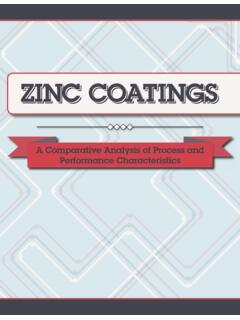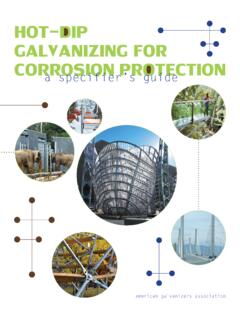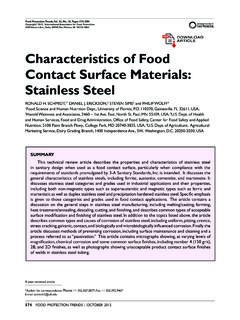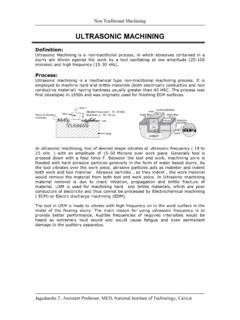Transcription of Hot-Dip Galvanizing to ASTM A123 Fact Sheet
1 Hot-Dip Galvanizing to astm a123 fact Sheet Hot-Dip Galvanizing (HDG) is the process of dipping fabricated steel into a kettle or vat containing molten zinc. While the steel is in the kettle, the iron in the steel metallurgically reacts with the molten zinc to form a tightly-bonded alloy coating that provides superior corrosion protection to steel. The Hot-Dip Galvanizing (HDG) process consists of three basic steps: Surface Preparation Galvanizing Inspection Surface Preparation Surface preparation is a critical step in the application of any coating. The Galvanizing process has its own built-in means of quality control because zinc will not react with an unclean steel surface.
2 Any failures or inadequacies in surface preparation will be immediately apparent when the steel is withdrawn from the zinc bath because the unclean areas will remain uncoated, and immediate corrective action can be taken. Surface preparation for Galvanizing consists of three steps: Degreasing/Caustic Cleaning A hot alkali solution, mild acidic bath, or biological cleaning bath removes organic contaminants such as dirt, paint markings, grease, and oil from the metal surface. Epoxy, vinyl, asphalt, or welding slag, which cannot be removed by degreasing, must be removed before Galvanizing by grit-blasting, sand-blasting, or other mechanical means. Pickling A dilute solution of heated sulfuric acid or ambient hydrochloric acid removes mill scale and iron oxides (rust) from the steel surface.
3 As an alternative to or in conjunction with pickling, this step can also be accomplished using abrasive cleaning or air blasting sand, metallic shot, or grit onto the steel. As long as the surface of the steel is completely cleaned to bare metal and all non-metallic substances removed, the Galvanizing reaction is indifferent to the manner of cleaning. Fluxing The final surface preparation step in the Galvanizing process, a zinc ammonium chloride solution, serves two purposes. It removes any remaining oxides from the surface of the steel, and deposits a protective layer on the steel to prevent any further oxides from forming on the surface prior to immersion in the molten zinc.
4 Galvanizing During the actual Galvanizing step of the process, the material is completely immersed in a bath of molten zinc. The bath chemistry is specified by astm a123 and requires at least 98% pure zinc by weight maintained at a temperature above the melting point of zinc. The zinc metal in the bath must meet the requirements of astm B6 or astm B960. While the steel is immersed in the kettle, zinc reacts with iron in the steel to form a series of metallurgically-bonded zinc-iron intermetallic alloy layers, commonly topped by a layer of pure zinc metal from the bath. Once the fabricated items coating growth is complete, it is withdrawn slowly from the Galvanizing bath, and the excess zinc is removed by draining, vibrating, and/or centrifuging.
5 The metallurgical reaction will continue after the materials are withdrawn from the bath, as long as the steel part remains near bath temperature. Galvanized articles are cooled either by immersion in a passivation solution or water, or by being left in open air. Inspection The inspection of Hot-Dip galvanized steel is simple and quick. The two properties of the Hot-Dip galvanized coating most closely scrutinized are coating thickness and appearance/surface condition. A variety of simple physical tests can be performed to determine thickness, uniformity, adherence, and appearance. Fabricator -- Controllable Variables To promote the best possible outcome from the Hot-Dip Galvanizing process, the fabricator should consider controlling several variables which impact the coating appearance and characteristics.
6 Steel with a specific chemistry is known to most often result in a galvanized coating with a coating thickness above the minimum specified in astm a123 . Steel with silicon and phosphorous outside the ranges prescribed in astm A385 can result in excessively thick zinc coatings which can lead to delamination when impacted by outside forces during handling and erection. Bath additives are often used to minimize the coating growth to a level near the minimum thickness but are not effective for all steels. Decreasing the immersion time in the molten zinc to result in a thinner zinc coating is not always possible. Steel with properly designed vent and drain holes, cropped gusset plates, and seal-welded overlapping surfaces as prescribed by astm A385 will most often result in a galvanized coating without excess zinc buildup inside or outside the steel article.
7 Optimal immersion and removal speed from the molten zinc bath is a slow, steady rate. This allows even heating during immersion and even freezing of the zinc during removal. Too few or too small drain and vent holes make immersion and removal very slow and inefficient, and the result is a very uneven coating. Poor seal welds or stitch welding causes blowout of trapped chemicals from the overlapped surfaces and steel around the weld area may remain ungalvanized. Welded steel free of flux and slag and the use of weld rod similar in chemistry to the steel being welded. Residual flux and slag are not always visible to the galvanizer and are not removed during the chemical cleaning steps.
8 The result is ungalvanized areas around the weld. If the weld rod is dissimilar in chemistry to the steel being welded, the zinc reaction with the weld metal will likely yield a different appearance and different coating thickness compared to the steel members. Stress-relieving steel/weld bead near the area of flame-cut cope edges. The thermal gradient inherent in the Galvanizing process affects the residual stresses in structural steel caused by flame cut copes. If there is no stress-relieving prior to Galvanizing , the cope cut areas may exhibit cracks after Galvanizing . The fabricator may alternatively place weld bead on the beam web adjacent to the cope area, thereby relieving some of the residual stress in this area.
9 Minimize cold-working, but if necessary, do it in accordance with recommended bend radius. Cold-working induces stress into structural steel and the excess residual stress can age the steel at Galvanizing temperatures, thereby changing the steel properties. The heat of the Galvanizing process accelerates the appearance of cracks but does not cause the cracks. Use removable steel tags, weld bead, or stenciling to mark fabricated pieces. Paint, lacquer, and some marking pen material are not removed in the cleaning process and must be removed mechanically prior to beginning the Galvanizing process. Fabricator -- Uncontrollable Variables Steel production is not a precise process in terms of resulting chemistry and an even distribution of elements throughout.
10 Some fabrications combine steels of varying chemistry and thickness. Both influence the outcome of the galvanized coating appearance and the implications for the fabricator are as follows. Fabrications using two or more steel thicknesses of the exact same chemistry One of the advantages of Hot-Dip Galvanizing is total immersion so there is complete protection of all steel surfaces , tight joint areas, and internal spaces. When a fabrication comprised of two or more steel thicknesses is immersed, the thinner steel heats up to the bath temperature sooner than the thicker steel. The reaction time between the iron in the steel and the zinc will be different and may result in two quite different appearances ranging from bright/shiny to matte gray.















